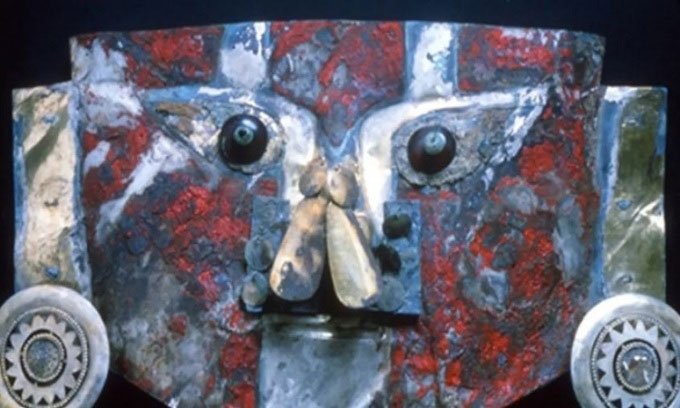The ancient mask placed on the skull used human blood, reflecting the desire for rebirth of the tomb’s owner.
Researchers working on the Sicán archaeological project discovered a gold mask in the 1990s while excavating an ancient tomb in Peru. The tomb, dating back to around 1000 AD, belonged to a middle-aged elite man from the Sicán civilization, which thrived along the northern coast of Peru from the 9th to the 14th century. The brightly painted red skeleton was found without a skull and positioned face down in a square tomb that was 12 meters deep.

Gold mask in the thousand-year-old tomb. (Image: Proteome Research)
The skull was found separately from the skeleton, positioned upright and adorned with a red-painted mask. Inside the tomb, the archaeological team discovered 1.1 tons of burial goods and the remains of four other individuals, including two young women placed in the positions of a midwife and a mother giving birth, along with two children crawling on a higher step.
At the time of excavation, scientists identified the red streaks on the mask as vermilion, a bright red mineral composed of mercury and sulfur. Despite being buried under layers of earth for 1,000 years, the 1-2 mm thick red streak remained firmly attached to the mask.
In a recently published study in the journal Proteome Research of the American Chemical Society, chemist Elisabete Pires from the University of Oxford and her team analyzed samples taken from the red streak to uncover the secret components that allowed it to adhere to the mask. First, using infrared spectroscopy to identify material components, the research team found that the red streak contained proteins. They then employed mass spectrometry, a method that classifies different ions in materials based on their charge and mass, to identify specific proteins.
The red streak contained six proteins from human blood and proteins derived from egg whites. Most of the proteins had degraded, making it impossible to determine the exact species of bird from which the eggs came. However, the research team hypothesized that they could be from Muscovy duck eggs (Cairina moschata).
Vermilion was commonly used by the elite class and held significant importance in rituals. The ancient lower classes used a type of ochre paint to adorn objects.
Previously, archaeologists believed that the arrangement of the skeletons reflected the deceased Sicán chief’s desire for “rebirth.” To facilitate this rebirth, the ancients covered the entire skeleton with a paint containing blood, symbolizing fresh red blood or “life force.” Recent analyses revealed that the Sicán civilization practiced human sacrifice by cutting into the neck and chest to maximize blood flow. Therefore, from an archaeological perspective, the practice of using human blood in the paint is not surprising.


















































